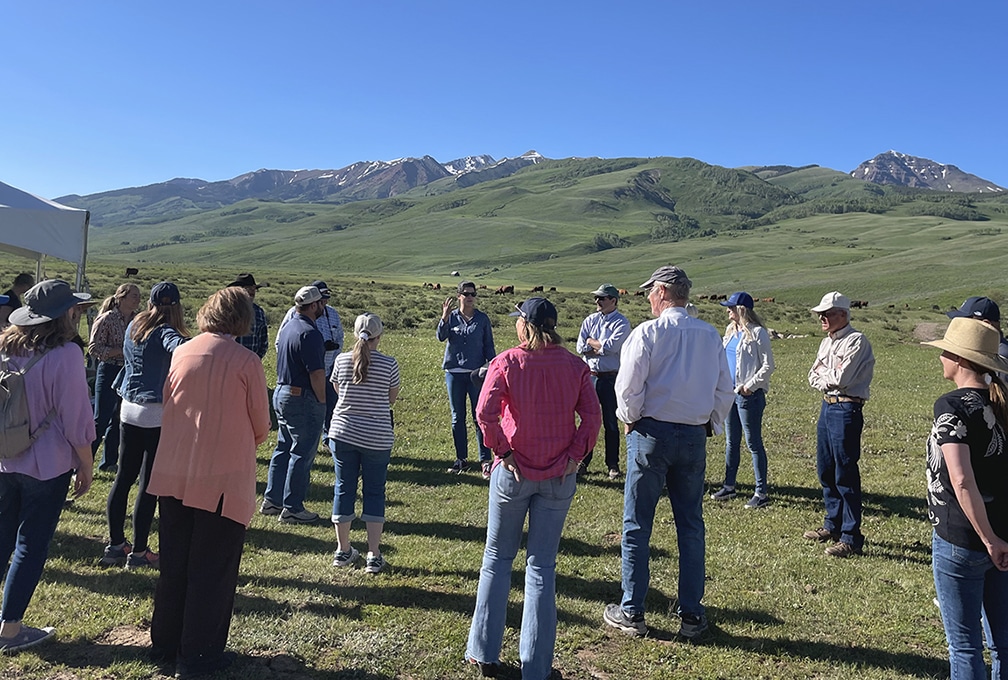Partner Profile: Colorado River Water Conservation District
October 25, 2023
Working with trusted partners in watersheds across the West is invaluable to fulfilling TFT’s mission to preserve and protect freshwater ecosystems. In the past four years, we’ve brought our analytics and water policy chops to three basins in Colorado to help build resilience in agricultural and ecological systems in a water-constrained present and future. We recently chatted with Raquel Flinker, a senior water resources engineer at the Colorado River Water Conservation District in Glenwood Springs, Colorado. Her organization has a multi-faceted approach to protecting water users on the west side of the Rocky Mountains.
Can you share in a few words what your organization does?
The Colorado River District is a regional government entity representing water interests across 15 counties on Colorado’s Western Slope. In short, we are the West Slope’s water watchdog. We work to keep water flowing west, ensuring water security for all water users and future generations dependent on the Upper Colorado River and its tributaries. We’re also charged with safeguarding the water of the Colorado River to which the state of Colorado is entitled within the larger Colorado River Basin.
What is the most unique aspect of your organization?
Water in the West is no small issue, but the Colorado River District works across all levels to protect and advocate for West Slope water security including extensive outreach and events, technical advocacy, state and federal water policy, water law, grant funding, and collaborative partnerships. We do it all with a small and talented staff of 25 to help our water users engage in the complex issues of our time, pursue innovative projects large and small, and adapt to a hotter, drier future.

Raquel Flinker, senior water resources engineer at the Colorado River Water Conservation District. Photo provided by Raquel Flinker.
How did you get into this profession?
My interest in water resources ramped up in college while I pursued an undergraduate degree in environmental engineering in my home country of Brazil. After college, I worked in engineering consulting and the beverage industry in both the United States and Brazil; I found that traditional engineering consulting and sales work wasn’t what I wanted to do. I went on to get a master’s degree in hydrology at the University of Texas in Austin. My experience in water resources, municipal engineering, and government work at the City of Aspen was very gratifying and made it clear that I enjoy working with water resources in the public sector.
My position at the River District strongly aligns with my interests and experience and is a great blend of technical and relational work, which is ideal for me.
Why are you passionate about water resources issues?
My passion comes from growing up in Brazil. I grew up in a city that has a lot of nature around, which I really valued. Seeing and interacting with it built my love for natural resources, particularly after witnessing reoccurring water pollution issues. My grandparents lived in Israel, where water quantity is an issue. When my family visited them, we had to use water very carefully (not much was available for our bath water!). The difference between the arid desert climate in Israel and the wet tropical climate of Brazil stuck with me.
How did your organization first start working with The Freshwater Trust?
We started working with TFT in 2022. The Bureau of Reclamation made a call that summer to reduce consumptive water use across the Colorado River Basin by 2 to 4 million acre feet per year as an urgent drought response measure and to preserve the major infrastructure they operate at Lakes Powell and Mead. Current annual use has averaged around 15 million acre feet for the seven states, 40 sovereign tribal nations, and Mexican communities across the border that all rely on its waters, so the reduction is significant.
“Demand Management” is a drought response approach that the River District has studied for over 10 years with many partners and stakeholders. It can be a controversial topic for water users, but if a demand management program were implemented by the Upper Colorado River Commission, essentially it would offer financial compensation to water users for temporary, voluntary reductions. We want to be proactive rather than reactive if a program like this is authorized at a broader level and make sure protections are in place for West Slope water, being especially mindful of potential negative economic impacts to our communities and preventing any injury to other water users.
As such, we’re working with TFT to strategically prioritize outcomes from water reductions. TFT is creating a data-driven tool that will help us and our producers balance water usage and economic impact as we navigate our changing climate and the tough decisions that come with it.
We’re calling it the “Water Conservation Decision Support Tool” or DST.

Raquel leading a tour of Colorado’s West Slope water for the Central Arizona Project Board and upper management. The group visited a ranch in Crested Butte to learn more about ranching operations in the Upper Gunnison as well as wet meadows restoration. Photo provided by Colorado River Water Conservation District.
Tell me about a few goals of your organization for the next years.
Over the next couple years, there will be lots of conversations around operations at Lake Powell and Lake Mead. The current set of operating guidelines expire in 2026 and new guidelines are already beginning to take shape through a negotiation process involving Colorado River Basin stakeholders and the Bureau of Reclamation. We are living in a hotter and drier hydrology than we were decades ago. And here in Colorado, especially on the Western Slope in the Colorado River’s natural basin, we’re limited by hydrology – without big reservoirs like Powell and Mead above us, we depend on the seasonal rain and snow to determine how much water we have to work with each year (and when it runs dry, it’s done). So how do we help our communities thrive and be more resilient?
Our work will continue to include collaboration among agricultural, municipal, industrial, and recreational water users to find innovative and long-term solutions.
Why do you like working with The Freshwater Trust?
My experience working with TFT has been positive. TFT listens to our needs and is responding thoughtfully in their efforts to create a robust decision support tool that explores many complex factors. Multiple people are working on very specific layers of data. It’s a user-friendly tool that will allow us to look spatially at information – that’s powerful.
#agriculture #Colorado #Colorado River #Watershed
